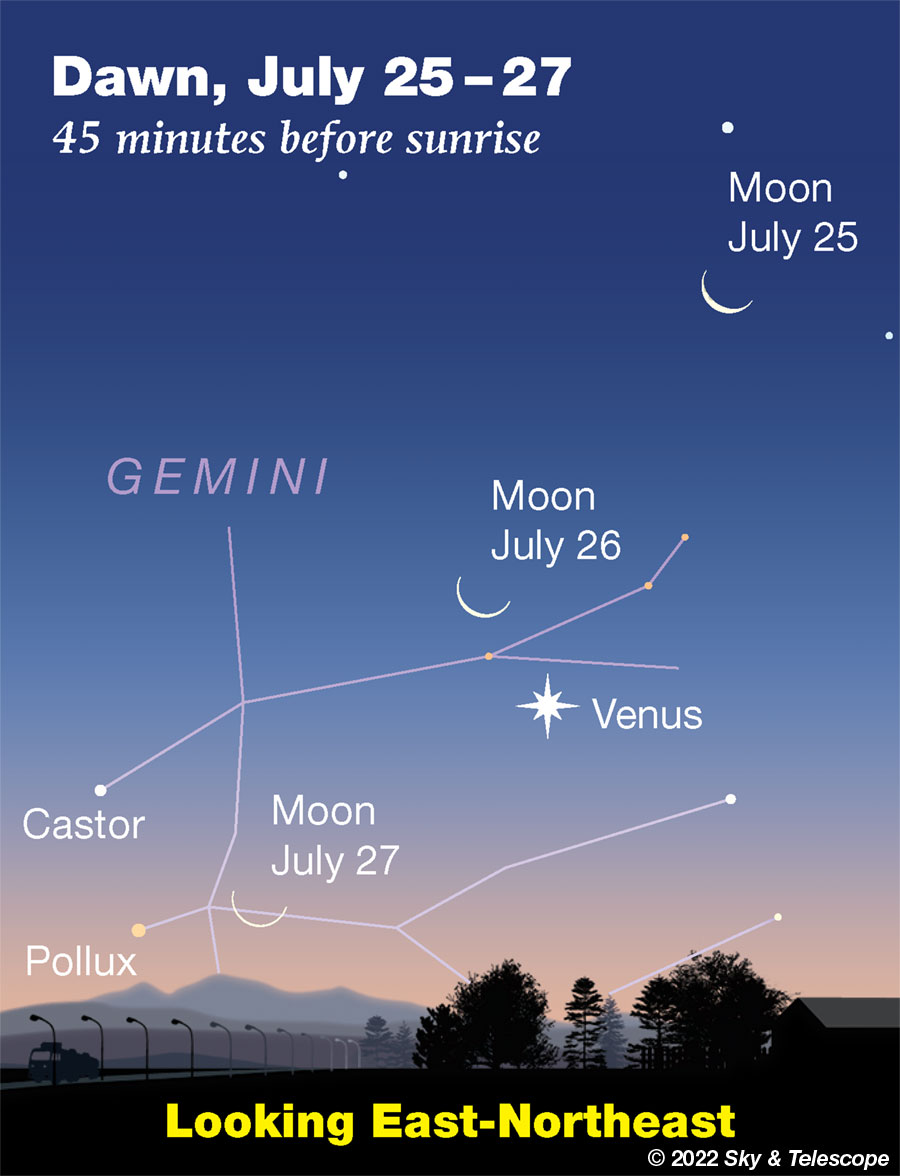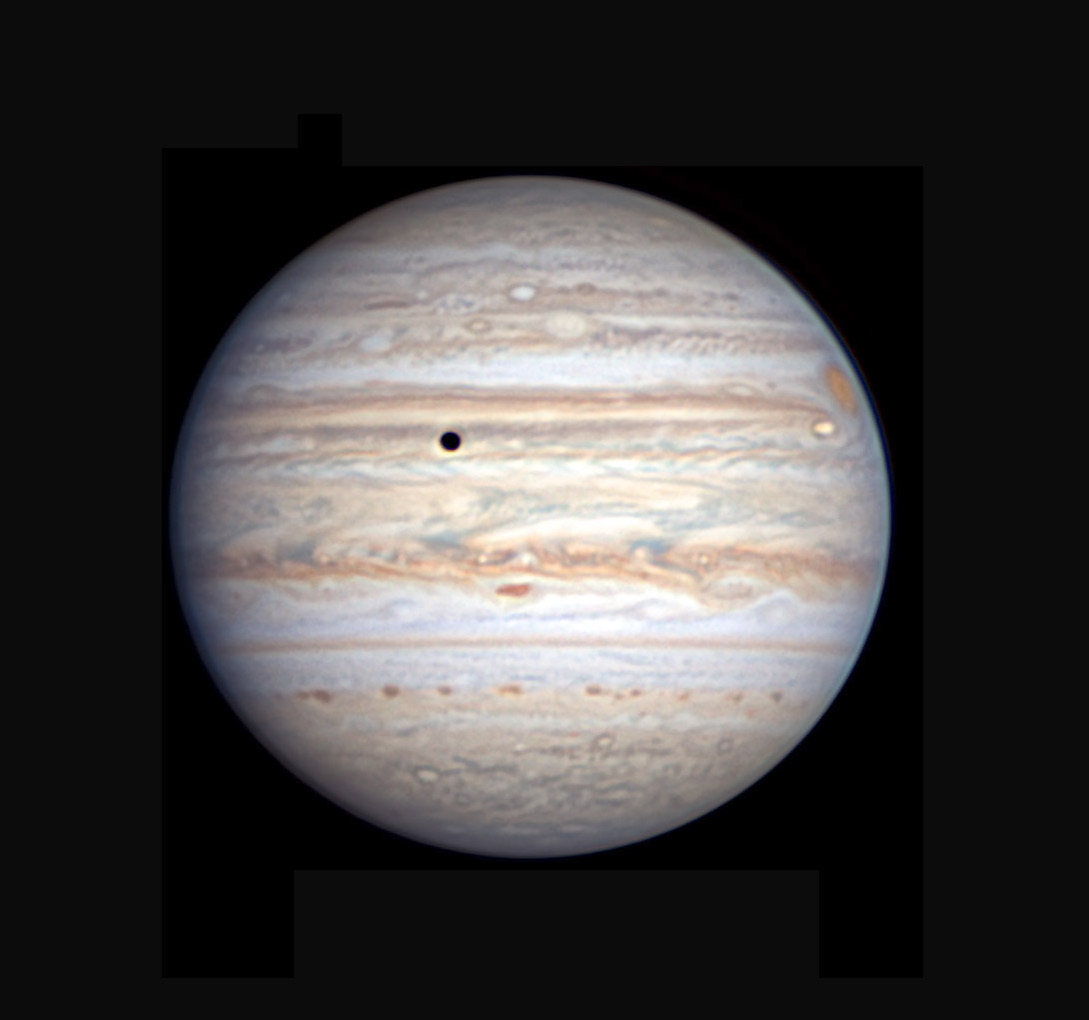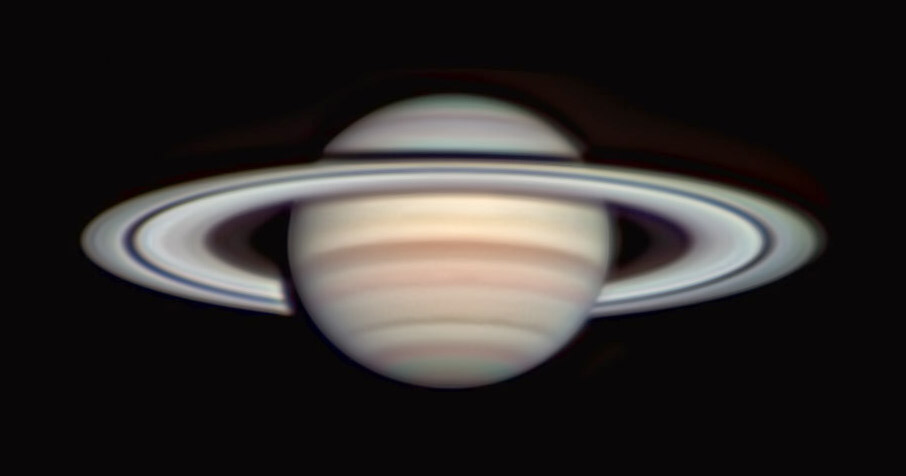FRIDAY, JULY 22
■ Fourth star of the Summer Triangle. The next-brightest star near the Summer Triangle, if you want to turn it into a quadrilateral, is Rasalhague, the head of Ophiuchus, magnitude 2.0. Face south soon after dark. You'll find Rasalhague (Alpha Ophiuchi) about equally far to the right of Altair and lower right of Vega.
Altair is currently the Summer Triangle's lowest star. Vega, nearly overhead, is the brightest. The "Summer Quadrilateral" covers a little more than twice the area of the Summer Triangle.
■ Out real late on this Friday night? By about 2 a.m. Saturday morning, the waning crescent Moon comes up in the east. Look just a few degrees above it for the Pleiades. As the Moon-Pleiades panorama climbs higher, watch for Aldebaran to rise into view farther below.
SATURDAY, JULY 23
■ Bright Arcturus is still pretty high after dark, but as summer progresses, it moves down the western side of the evening sky. Its pale ginger-ale tint always helps identify it. Off to the right of Arcturus right is the Big Dipper.
Arcturus forms the bottom point of the Kite of Bootes. The Kite, rather narrow, extends upper right from Arcturus by 23°, about two fists at arm's length. The lower side of the kite is dented inward, as if some invisible celestial intruder banged into it.
SUNDAY, JULY 24
■ We're only about a third of the way through summer, but already Cassiopeia is getting well up after dark. Look for its tilted W pattern in the north-northeast.
High above it is dimmer Cepheus. Below it, the head of Perseus is on the rise. The farther north you live the higher they all will appear.
■ On Monday morning the 25th, the crescent Moon in the east at dawn points down more or less toward Venus, as shown below.

MONDAY, JULY 25
■ Starry Scorpius is sometimes called "the Orion of Summer" — for its brightness, its blue-white giant stars, and its prominent red supergiant (Antares in the case of Scorpius, Betelgeuse for Orion). But for those of us at mid-northern latitudes, Scorpius passes a lot lower across the southern sky than Orion does. That means it has only one really good evening month: July.
Catch Scorpius due south just after dark now, before it starts to tilt lower toward the southwest. It's full of deep-sky objects to hunt with binoculars or a telescope.
■ As dawn brightens on Tuesday morning the 26th, the thin waning crescent Moon hangs just a couple degrees above Venus low in the east-northeast, as shown above.
TUESDAY, JULY 26
■ Arcturus dominates the high western sky after dark. Spot the Big Dipper off to its right, in the northwest.
In astronomy lore today, Arcturus may be best known for its cosmic history: It's a Population II orange giant some 7 billion years old, older than the solar system, racing by our part of space on a trajectory that indicates it came from another galaxy: a dwarf galaxy that fell into the Milky Way and merged with it.
But in the astronomy books of our grandparents, Arcturus had a different claim to fame: It turned on the lights of the 1933 World's Fair in Chicago, celebrating "a century of progress." Astronomers rigged the newly invented photocell to the eye end of big telescopes around the US and aimed the scopes where Arcturus would pass at the correct moment on opening night. In places where the sky was clear the star's light crept onto the photocells, the weak signals were amplified and sent over telegraph wires to Chicago, a switch was tripped, and on blazed the massive lights to the cheers of tens of thousands.
Why Arcturus? Astronomers of the time thought its was 40 light-years away (modern value: 36.7 ±0.2 light-years). So the light would have been in flight since the previous such great event in Chicago, the World's Columbian Exhibition in 1893.
And earlier? Arcturus was known as the first of the familiar nighttime stars to be seen in the daytime with a telescope: by Jean-Baptiste Morin in 1635.
WEDNESDAY, JULY 27
■ You probably know that the Big Dipper's curved handle "arcs to Arcturus." But the arc of the handle itself, extended to include the adjacent side of the Dipper's bowl, guides the way to another landmark. Fairly near the focus of that longer arc (the center of the circle that the arc would be part of) is 3rd-magnitude Cor Caroli, Alpha Canum Venaticorum. This is a lovely double star for small telescopes: colors white and pale yellow-white, separation a generous 23 arcseconds.
THURSDAY, JULY 28
■ Can you spot the Northern Coal Sack? It's named for the more famous Coal Sack, the naked-eye dark nebula next to the Southern Cross. The northern version is a subtler dark nebula in Cygnus. You'll need a moonless night, like the evenings this week, and a fine dark sky in which the Milky Way stands out in detail.
Face east after dark and look very high, almost overhead. The brightest star there is Vega. Look about two fists at arm's length lower left of Vega, and there's Deneb, the brightest star of Cygnus.
To Deneb's right, along the outstretched neck of Cygnus the stick-figure Swan, is the Cygnus Star Cloud, one of the brightest stretches of the Milky Way. But there's a gap between the star cloud and Deneb. The darkest part of that gap is the Northern Coal Sack. Deneb shines right on its edge.
In a dark enough sky, or in photos, the Milky Way background outlines it well enough to make it pretty distinct. It's part of the Great Rift complex of dark nebulae that runs the entire length of the summer Milky Way.
Actual coal sacks were part of everyday life a few generations ago. The name turned out to be truer than its unknown inventor may have thought. Interstellar dust consists not just of silicates (rock dust) but carbon dust too — not from fossilized plant matter, but from the smoky carbonaceous exhalations of red-giant stars in the late stages of their lives.
■ New Moon (at 1:55 p.m. EDT).
FRIDAY, JULY 29
■ The Big Dipper hangs diagonally in the northwest after dark. From its midpoint, look to the right to find Polaris (not very bright) glimmering due north as always.
Polaris is the end of the Little Dipper's handle. The only other Little Dipper stars that are even moderately bright are the two forming the outer end of its bowl: 2nd-magnitude Kochab and 3rd-magnitude Pherkad. Find them to Polaris's upper left, one over the other, by about a fist and a half at arm's length. They're called the Guardians of the Pole, since they ceaselessly circle around Polaris through the night and through the year.
SATURDAY, JULY 30
■ Face southeast after darkness is complete. Look a little more than halfway from horizontal to overhead, and there's Altair, the brightest star in that immediate area. A finger-width above it is its little sidekick Tarazed (Gamma Aquilae), two magnitudes fainter and far in the background. Tarazed is actually 100 times more luminous than Altair — it's an orange giant — but it's 390 light-years away compared to Altair's distance of just 17 light-years.
■ Look left of Altair by a bit more than a fist for compact little Delphinus, the Dolphin, leaping leftward in the edge of the Milky Way.
Closer to Altair's upper left is Sagitta the narrow Arrow, smaller and dimmer than Delphinus. The arrow points left. Binoculars help with both.
This Week's Planet Roundup
Mercury is hidden deep in the glow of sunset.
Venus, magnitude –3.9, continues to rise just as dawn begins. As dawn brightens, look for it low in the east-northeast. It's far below Capella.
Mars, magnitude +0.2 in Aries, rises around midnight or 1 a.m. and shines high in the east-southeast as dawn begins. It's about three fists lower left of bright Jupiter. By dawn they're high in the south, with Mars now directly left of Jupiter.
Mars is still quite small in a telescope, 8 arcseconds in apparent diameter.
Jupiter, a bright magnitude –2.6 (at the Pisces-Cetus border), rises due east around 11 p.m. It's at its highest in the south as dawn begins. It's now 43 arcseconds wide.

On this side of the planet, the South Equatorial Belt is divided into two thin dark lines. The North Equatorial Belt looks more turbulent than we've seen it recently.
Saturn, magnitude +0.4 in western Capricornus, rises in twilight and glows low in the east-southeast after dark. The little star 1½° below it is Delta Capricorni, magnitude 2.8. Saturn is highest in the south for best telescopic viewing around 2 a.m. Saturn's rings appear roughly as wide, end to end, as Jupiter's disk.

On the lower left, we see the shadow of the globe on the rings behind it. Christopher Go took this image on April 22nd.
Uranus, magnitude 5.8 in Aries, is high in the east before the first light of dawn, east of Mars.
Neptune, magnitude 7.9 at the Aquarius-Pisces border, is high in the south before the first light of dawn, west of Jupiter.
All descriptions that relate to your horizon — including the words up, down, right, and left — are written for the world's mid-northern latitudes. Descriptions and graphics that also depend on longitude (mainly Moon positions) are for North America.
Eastern Daylight Time, EDT, is Universal Time minus 4 hours. (Universal Time is also called UT, UTC, GMT or Z time.)
Want to become a better astronomer? Learn your way around the constellations. They're the key to locating everything fainter and deeper to hunt with binoculars or a telescope.
This is an outdoor nature hobby. For an easy-to-use constellation guide covering the whole evening sky, use the big monthly map in the center of each issue of Sky & Telescope, the essential magazine of astronomy.
Once you get a telescope, to put it to good use you'll need a detailed, large-scale sky atlas (set of charts). The basic standard is the Pocket Sky Atlas (in either the original or Jumbo Edition), which shows stars to magnitude 7.6.

Next up is the larger and deeper Sky Atlas 2000.0, plotting stars to magnitude 8.5; nearly three times as many. The next up, once you know your way around, are the even larger Interstellarum atlas (stars to magnitude 9.5) or Uranometria 2000.0 (stars to magnitude 9.75). And be sure to read How to Use a Star Chart with a Telescope. It applies just as much to charts on your phone or tablet as to charts on paper.
You'll also want a good deep-sky guidebook. A beloved old classic is the three-volume Burnham's Celestial Handbook. An impressive more modern one is the big Night Sky Observer's Guide set (2+ volumes) by Kepple and Sanner.
Can a computerized telescope replace charts? Not for beginners, I don't think, and not on mounts and tripods that are less than top-quality mechanically, meaning heavy and expensive. And as Terence Dickinson and Alan Dyer say in their Backyard Astronomer's Guide, "A full appreciation of the universe cannot come without developing the skills to find things in the sky and understanding how the sky works. This knowledge comes only by spending time under the stars with star maps in hand."
![]() Audio sky tour. Out under the evening sky with your
Audio sky tour. Out under the evening sky with your
earbuds in place, listen to Kelly Beatty's monthly
podcast tour of the heavens above. It's free.
"The dangers of not thinking clearly are much greater now than ever before. It's not that there's something new in our way of thinking, it's that credulous and confused thinking can be much more lethal in ways it was never before."
— Carl Sagan, 1996
"Facts are stubborn things."
— John Adams, 1770
 2
2









Comments
Rod
July 22, 2022 at 6:24 am
Some early morning viewing today of the Moon, Uranus, and 53 Arietis star in Aries.
[Observed 0400-0500 EDT/0800-0900 UT. Sunrise 0559/EDT 0959 UT. Last Quarter Moon 20-July-2022 1419 UT. I used 90-mm refractor telescope with TeleVue 40-mm plossl for 25x views, true FOV ~ 108 arcminute. Stellarium shows the Moon and Uranus ~ 82 to 95 arcminute angular separation in Aries when I viewed. Uranus easy to locate and view but cirrus did obscure somewhat this morning. Uranus and 53 Arietis star a distinct pair in the telescope eyepiece view too. I used Stellarium 0.22.2, Starry Night Pro Plus 8, and Virtual Moon Atlas. The lunar terminator line visible in FOV with Uranus this morning. Virtual Moon Atlas shows the Moon angular size ~ 30.28 arcminute, while Uranus angular size about 3.5 arcsecond. Uranus some 20 AU distance while 53 Arietis according to Stellarium 1029 light years. The Moon's distance somewhat more than 394000 km. A great horn owl was hooting, cirrus did cause some obscuration while viewing. Winds 225/4 knots, temperature 22C.]
You must be logged in to post a comment.
Rod
July 25, 2022 at 5:51 am
Near 0440 EDT this morning, I could see (naked eyes) the thin, waning crescent Moon with earthshine in Taurus, low in ENE sky. Aldebaran in Taurus, M45 (Pleiades) in Taurus, Mars in Aries, and Jupiter in Cetus. Sunrise 0602 EDT. I thought about some telescope time viewing but altocumulus and cirrus clouds in my area caused some obscuration.
You must be logged in to post a comment.
You must be logged in to post a comment.